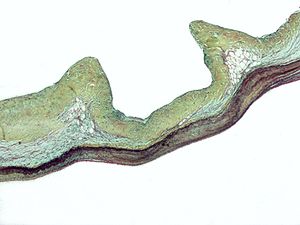Aortic insufficiency
| Aortic insufficiency | |
|---|---|
 |
|
| Micrograph of myxomatous degeneration – a cause of aortic insufficiency. | |
| Classification and external resources | |
| Specialty | medical genetics |
| ICD-10 | I06, I35, Q23.1 |
| ICD-9-CM | 395.1, 746.4 |
| DiseasesDB | 829 |
| MedlinePlus | 000179 |
| eMedicine | med/156 emerg/39 ped/2487 |
| MeSH | D001022 |
Aortic insufficiency (AI), also known as aortic regurgitation (AR), is the leaking of the aortic valve of the heart that causes blood to flow in the reverse direction during ventricular diastole, from the aorta into the left ventricle. As a consequence the cardiac muscle is forced to work harder than normal.
Symptoms of aortic insufficiency are similar to those of heart failure and include the following:
In terms of the cause of aortic insufficiency, is often due to the aortic root dilation (annuloaortic ectasia), which is idiopathic in over 80% of cases, but otherwise may result from aging, syphilitic aortitis, osteogenesis imperfecta, aortic dissection, Behçet's disease, reactive arthritis and systemic hypertension. Aortic root dilation is the most common cause of aortic insufficiency in developed countries. Additionally, aortic insufficiency has been linked to the use of some medications, specifically medications containing fenfluramine or dexfenfluramine isomers and dopamine agonists. Other potential causes that affect the valve directly include Marfan syndrome, Ehlers–Danlos syndrome, ankylosing spondylitis, and systemic lupus erythematosus. In acute cases of aortic insufficiency, the main causes are infective endocarditis, aortic dissection or trauma.
...
Wikipedia
